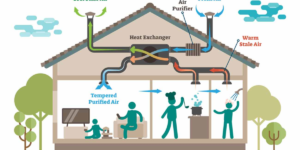How Do Heat Recovery Ventilation Systems Work
Heat recovery ventilation systems (HRVs) play a crucial role in maintaining optimal indoor air quality while maximizing energy efficiency. This comprehensive guide will delve into the intricate workings of these systems, shedding light on their mechanisms and benefits.
The Basics of Heat Recovery Ventilation:
What is HRV?
Heat recovery ventilation involves the exchange of stale indoor air with fresh outdoor air while retaining the indoor heat. This process ensures a constant supply of clean air without compromising energy efficiency.
Core Components:
Understanding the key components, such as heat exchangers, filters, and fans, is fundamental. The heat exchanger is the heart of an HRV system, facilitating the transfer of heat between outgoing and incoming air streams.
Operating Principles:
Air Extraction:
Stale indoor air is extracted from areas like kitchens and bathrooms, carrying with it pollutants and excess moisture. This air then passes through the heat exchanger.

Heat Exchange:
The heat exchanger efficiently transfers heat from the outgoing air to the incoming fresh air. This process prevents heat loss during ventilation, contributing to energy conservation.
Air Distribution:
The now pre-warmed, clean air is distributed to various rooms, ensuring a continuous and balanced flow. This distributed air displaces the stale air, creating a healthier indoor environment.
Benefits of HRV Systems:
Improved Indoor Air Quality:
By continuously replacing stale air with fresh, filtered air, HRV systems mitigate indoor pollutants, allergens, and excess humidity, fostering a healthier living environment.
Energy Efficiency:
The heat recovery process minimizes heat loss during ventilation, making HRV systems an energy-efficient solution. This leads to reduced heating and cooling costs.
Comfort and Well-being:
Maintaining a consistent indoor temperature and quality of air enhances overall comfort and well-being for occupants, particularly in cold climates.
Considerations and Maintenance:
Proper Sizing:
Selecting the right-sized HRV system is crucial for optimal performance. Factors like building size, occupancy, and climate must be considered.
Regular Maintenance:
Periodic cleaning and filter replacement ensure the continued efficiency of the HRV system. Routine checks on fans and ducts are also essential.
Heat recovery ventilation systems are pivotal in creating a healthy indoor environment while simultaneously promoting energy efficiency. Understanding their operation and benefits empowers homeowners and building managers to make informed decisions for enhanced comfort and well-being.
heat recovery ventilation systems
Heat recovery ventilation systems (HRVs) are integral to maintaining indoor air quality and energy efficiency. These systems extract stale indoor air, pass it through a heat exchanger, and distribute pre-warmed, clean air throughout the space. The heat recovery process minimizes energy loss during ventilation, making HRVs an eco-friendly solution. The benefits include improved air quality, energy efficiency, and enhanced comfort. Regular maintenance and proper sizing are essential considerations for optimal performance. Overall, comprehending the intricacies of HRV systems empowers individuals to create healthier, energy-efficient living and working environments.


